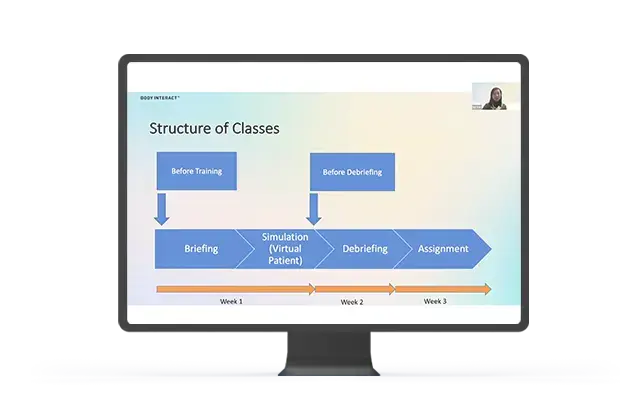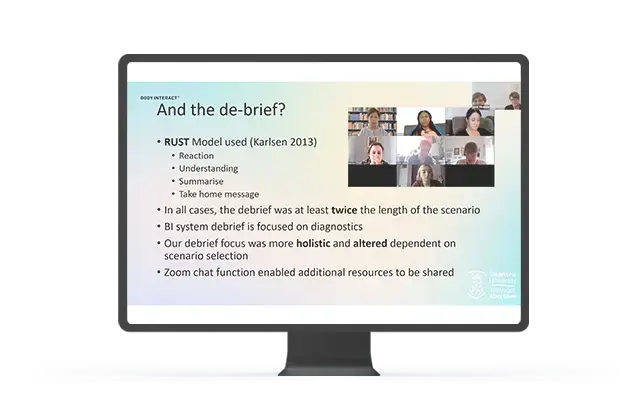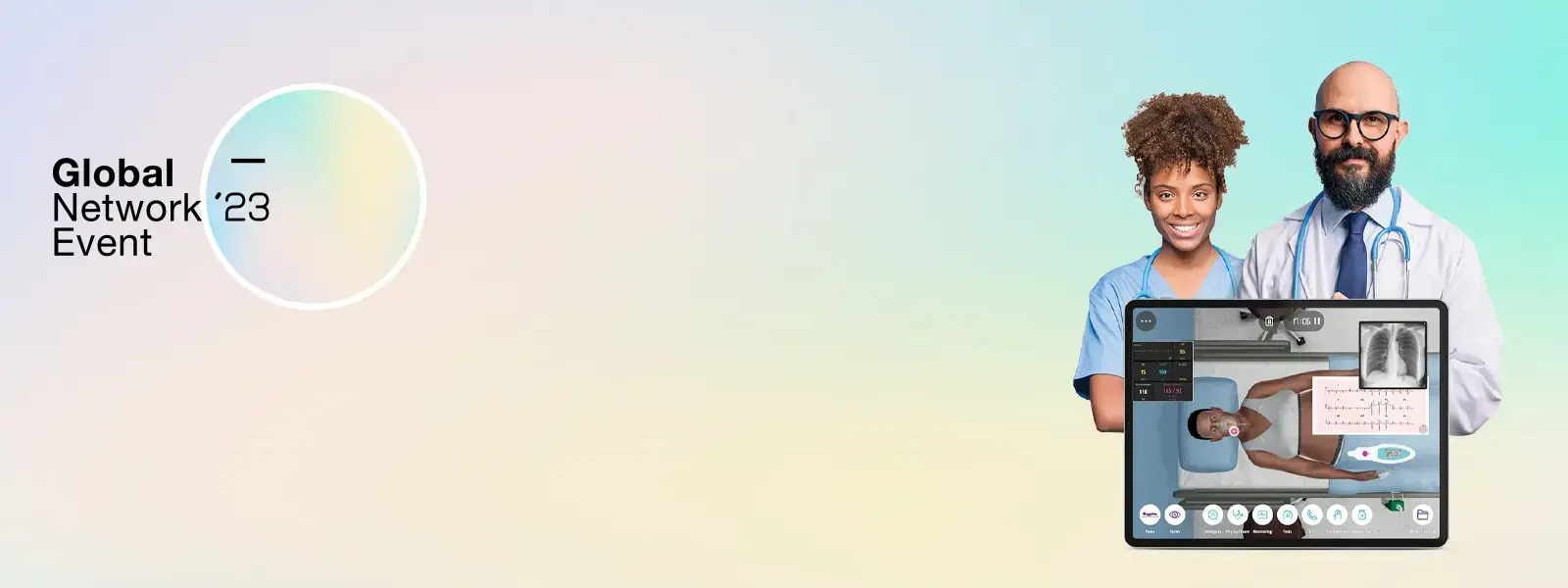Body Interact’s 3rd Edition of the Global Network Event took place on April 27th, 2023. Brought together eight healthcare professionals from different backgrounds and parts of the world who shared their valuable experiences and best practices. How are they using Virtual Patient Simulation in the various programs? This has been the motto of the Global Network Event since the first edition.
In this year’s edition, each speaker shared with the audience amazing contents, making the session truly inspiring. Take a look at the first three presentations below!

Yau Sui Yu Ivy
PhD, MBA(HSM), MNurs, PGDE, BNurs(Hons), RN, RT
Adopting Virtual Patients with Body Interact in Nursing Education during COVID-19
Hong Kong Metropolitan University, Hong Kong
In her talk, Dr. Ivy Yau discussed her approach to the adoption of Body Interact – Virtual Patients (VP) in Nursing Education during COVID-19. With her presentation, she aimed to:
- Introduce how Virtual Patients were adopted as an alternative mode for training in nursing education during COVID-19;
- Describe the design of classes adopting VP as a tool for teaching and learning, bearing in mind that interaction was maintained, the structure continued to offer clear learning outcomes, and still offer assessment components;
- Highlight the instructors’ and students’ feedback on adopting the referred tool in classes.
With the outburst of COVID-19, life was affected in different ways. Nursing classes were no exception. With the closure of the university campus and suspension of clinical placements and practical activities.
In this context, virtual patients emerge as the alternative for teaching, training, and learning. Due to its features, and as happened in other universities, Hong Kong Metropolitan University also turned to Virtual Patient Simulation to overcome the constraints of teaching and learning in COVID-19 times:
- Diversity of problem-based scenarios, with different levels of difficulty and complexity;
- Software highly interactive;
- Real-time patient monitoring.
Regarding the structure prepared by Prof. Ivy for the classes we highlight three main points:
- Clear indication of learning outcomes outlined for the session;
- Maintenance of interaction between instructors and students in the debriefing and briefing. Students were also encouraged to verbalize their experiences;
- Inclusion of assessment components, to determine if learning outcomes were achieved.

The structured aligned for this activity with Virtual Patient scenarios is divided into three moments:
1 – Briefing and simulation
For this implementation, all training materials and scenarios were revised by all instructors and all of these underwent Body Interact training.
- Before the training started the faculty prepared and checked access to the simulator for students and instructors;
- In the briefing phase, instructors presented the learning outcomes to students and provided practical tips on the software;
- After this, students were required to complete the scenario assigned
2 – Debriefing
Just before the debriefing session and after the students performed the scenarios by themselves, the instructors revised the collected data on students’ performance at the BI Studio (Learning Management System), in order to provide an effective debriefing session.
3 – Assignment
Students were required to have a defined assignment related to the activity. In conclusion, the feedback from both instructors and students was that Body Interact was an excellent tool to proceed with teaching and learning opportunities during the pandemic. Additionally, Body Interact is considered a highly interactive tool, providing a wide range of scenarios, enabling a safe environment for practice and the development of clinical reasoning skills.
Q&A
Audience (A): As a nursing professor what do you think are the biggest challenges in nursing education that Body Interact allows to overcome?
Professor Ivy Yau commented that the biggest challenge during COVID-19 was the suspension of classes. Body Interact represents a useful tool to sustain clinical learning. COVID-19 presented the opportunity for the Metropolitan University to explore the way to implement Virtual Patient Simulation in the curriculum. As the main advantages of using Body Interact, Professor Ivy Yau mentioned the possibility for students to practice skills and improve critical thinking without any risk to the patient. Also the chance of being exposed to different scenarios, with different levels of complexity. VP bridges the gap between theory and practice.
Audience (A): Do students have a better idea of preparing a care plan when they already attempted a Body Interact case beforehand?
From the Professors’ Ivy perspective, giving the opportunity for the students to perform a case before facilitates when it comes to preparing a care plan. It is an advantage to train cognitively the students. It provides them a more comprehensive picture of the patient.

David Abarca
MD
Sense and Decision-Making with Body Interact
Universidad de las Américas Puebla, Mexico
David Abarca is a Professor and investigator dedicated to the education of emergency staff. A physician with a Master’s Degree in Sciences with a focus on Health Education, with national and international certificates, in rescue and collapsed structures from the University of Texas.
He’s currently working at a third-level trauma center hospital as an attending physician in the Emergency Department and coordinates the clinical simulation at the Health Sciences department at the Universidad de las Américas Puebla. Professor Abarca collaborates with Eureka on online publications and his current investigations are based on metacognition in clinical simulation scenarios.
The focus of Professor Abarca was to present how the Body Interact has helped to improve the program in the medical areas of his university.
Body Interact is one of the simulators that the institution has licensed to compose the simulation program currently being imparted.
It has been used to achieve different purposes:
- In general medical sciences, the VP software has a key role to make a first approach and highlight the importance of clinical analysis;
- Simulate medical rounds in the hospital, for which different clinical scenarios are used to compose what the Professor calls ‘pase de visita’, in a rationale that starts when the patient gets to the hospital until they are discharged;
- Teach and train emergency medical residents, to validate patients’ physiological responses.
From the Professor’s words, we can conclude that the simulator and its most advantageous feature is the possibility to simulate the patient’s journey.
Virtual Patients provide the possibility to develop the skills necessary to navigate team dynamics and decision-making under pressure, one of the cornerstones of this program.
Currently, Professor Abarcas’ team is performing an investigation with Body Interact, with 3 cohorts, and partial results point to better reasoning and decision-making skills for the group that underwent Body Interact and manikins simulation.
One interesting line of thought presented by Professor Abarca relates to the two systems of Thinking. Originally proposed by the psychologists Keith Stanovich and Richard West.
System 1
Quick, instinctive, automatic, emotional, unconscious, with little to no effort being done
System 2
Slower, more logical, complex decisions, rational, conscious, effortful

As per reflection of Professor Abarca, Body Interact is a great tool to promote constant interaction between both systems.
To conclude, the Professor emphasizes that “the learning curve is steep and Body Interact plays a notable role in helping attain this goal”.
Q&A
Audience (A): Your current interest is the study of metacognition. Do you believe Virtual Patients have more benefits if used in guided classes with a tutor or used by students individually or even a combination of both?
In Professor David Abarca’s perspective, a combination of both systems is what works best. He mentioned that “if we are conscious of both of our systems we can develop proficient decisions”, and in order to “foster different types of skills and abilities it is necessary to combine a variety of simulators”.
Computer Based Simulation: The launch pad for student led learning
Jyoti Shrestha
MSc., PGCert., BN, RN (Adult)
Swansea University, United Kingdom
Sara Morris
MEd, MA, BN, RN (Adult and Child), SFHEA
Swansea University, United Kingdom
Jyoti Shrestha (MSc., PGCert., BN, RN) is a lecturer in adult Nursing at Swansea University, Wales, in the United Kingdom, with a particular interest in cardiac nursing, acute care, simulation-based learning, and clinical skills. Professor Jyoti Shrestha is predominantly involved in teaching widely within BSc. and MSc. Nursing program, including leading undergraduate nursing modules. A NMC registered adult nurse and teacher, Professor Jyoti Shrestha is an acute care nurse and has worked in various medical and surgical acute care settings in the National Health Service in England.
Sara Morris (MD, CHSE-A, MSc) is a lecturer in adult nursing at the same university. Professor Sara Morris’s current role includes Programme lead for the Post-graduate Certificate in blood components transfusion. She has expertise in teaching across undergraduate and postgraduate taught programs, for which her educational practice is rooted in pedagogy with particular interests in active approaches to learning. Expert in designing curricula, inquiry-based learning, and flipped learning, she joined Swansea University after a varied career in both the National Health Service and Higher Education in England, such as the University of Sheffield and Keele University.
Professors Jyoti Shrestha and Sara Morris’s presentation aimed to:
- Showcase Swansea University’s use of Body Interact software;
- Focus on the use of debriefing for student-led learning;
- Discuss tutor-facilitated learning;
- Share the student experience using the Virtual Patient Simulator.
Body Interact VP is being used in Swansea University both for the Nursing degree and as an ad hoc learning opportunity for healthcare groups, namely medicine, paramedics, midwifery, and advanced practice.
Within the Nursing School three approaches have been implemented:
- Self-guided use of cases (with independent synchronous kind of debrief);
- Self-directed use of cases with a facilitator providing the debrief;
- Academic hosted group (4-7 students per group) with facilitated debriefing.
Professor Jyoti mentioned that the students that underwent these sessions reflected that the debriefing was a step that felt like an advantage. It provides a deeper understanding of the case and, for which, at Swansea University they use the RUST debriefing model.

Students’ feedback on the sessions with Body Interact acknowledges the possibility to do collaborative work, reflecting on actions, diminishing the knowledge gaps, and recognizing the value of debriefing as a deeper learning opportunity.
Professor Sara Morris followed up the presentation by exploring the launchpad for student-led learning technique key concepts:
- The debriefing is a safe place to ask questions
- The students identify for themselves the learning gaps and difficulties
- The students signal what they wanted to focus on
The combination of the previous elements led to more motivated and confident students, willing to continue learning.
Relevant to reflect on were the conclusions provided by the data collected by the professors, namely:
- Facilitated group debriefing provided opportunities to learn with and from both learners and facilitators;
- Group debriefing motivated students to learn, and was appreciated as a way to clarify misconceptions.
As a take-home message, the duo of professors from Swansea was that “facilitated group debrief immediately after a group Body Interact activity is positively welcomed by our students as a launchpad for their own learning”.
Q&A
Audience (A): How do you believe the tool (Body Interact) can be used to optimize healthcare-based curricula?
Body Interact has been very useful at Swansea University for students to enrich and deepen their learning. It turned the lectures’ content more active, which means “putting clinical practice in action within the safety of a novice healthcare practitioner”.
By Daniela Abreu – Body Interact Instructional Designer

& Emanuel Dinis – Marketing Curricular Internship








